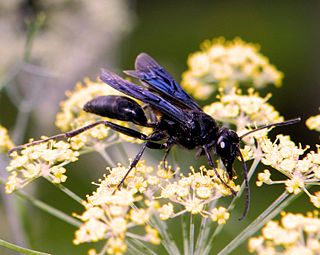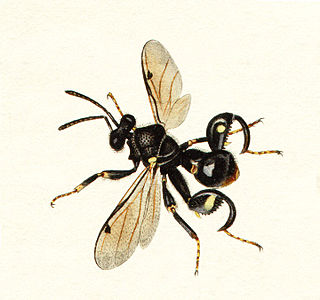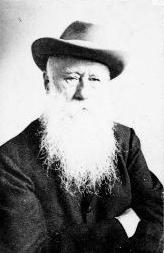Zdenek Bouček (born 8 January 1924, died 17 July 2011) was a Czech entomologist specialising in the Chalcidoidea superfamily of the Hymenoptera. With Marcus Graham and Richard Askew, Bouček was one of the most important workers studying this large and diverse group in the second half of the Twentieth Century and these three laid the foundations of the modern systematics of the chalcid wasps.

Hymenoptera is a large order of insects, comprising the sawflies, wasps, bees, and ants. Over 150,000 living species of Hymenoptera have been described, in addition to over 2,000 extinct ones.
Marcus William Robert deVere Graham (1915-1995) was an English entomologist who specialised in the Chalcidoidea superfamily of the Hymenoptera. He was associated with both Oxford University and Trinity College, Dublin.
Bouček was born in the Czech town of Hradec Králové on the 8 January 1924, [1] then part of Czechoslovakia. He married Tatiana Rydlova in 1949 and they had one daughter, Jitka. His first works as an entomologist were published while he was at the Univerzita Karlova in Prague and he later worked at an agricultural research centre before obtaining his Ph.D. from the Czechoslovak Academy of Sciences, his thesis being a "Revision of Chalcidoidea of Europe". [1] [2] In 1969 he was forced to flee Czechoslovakia as a result of the deterioration of the political situation following the Prague Spring and the subsequent Soviet invasion. [3] He took his family to the United Kingdom where he worked for a short time at the Hope Department at Oxford University before taking up a post at the Commonwealth Institute of Entomology which is located in the Natural History Museum, London where he worked until his retirement in 1989. [3]

Hradec Králové is a city of the Czech Republic, in the Hradec Králové Region of Bohemia. The city's economy is based on food-processing technology, photochemical, EMS and IT. Traditional industries include musical instrument manufacturing – the best known being PETROF pianos. The University of Hradec Králové is located in the city, the University of Defense has its only medical faculty in Hradec Králové and Charles University in Prague also has its Faculty of Medicine in Hradec Králové and Faculty of Pharmacy there.

Czechoslovakia, or Czecho-Slovakia, was a sovereign state in Central Europe that existed from October 1918, when it declared its independence from the Austro-Hungarian Empire, until its peaceful dissolution into the Czech Republic and Slovakia on 1 January 1993.

Charles University, known also as Charles University in Prague or historically as the University of Prague, is the oldest and largest university in the Czech Republic. Founded in 1348, it was the first university in Central Europe. It is one of the oldest universities in Europe in continuous operation and ranks in the upper 1.5 percent of the world’s best universities. Today, the university consists of 17 faculties located in Prague, Hradec Králové and Pilsen. Its academic publishing house is Karolinum Press. The university also operates several museums and two botanical gardens.
His main subject of taxonomic research was the Chalcidoidea, especially of the families which included those species with larger body sizes Leucospidae, Chalcididae, Pteromalidae, Torymidae and Eulophidae. [3] Among his publications was the 800+ page [3] book "Australasian Chalcidoidea" published in 1988. This work was so big that it took one person over two months to compile the taxonomic revisions it contained into the Zoological Record. [2] [3] Zdenek published over 150 papers and named over 1100 taxa of Hymenoptera including 47 families and 281 genera. [3] He was installed as an Honorary Fellow of the Royal Entomological Society in 2004 and was awarded the International Society of Hymenopterists Distinguished Research Medal in 2005. [3]

The Leucospidae are a specialized group within the Chalcidoidea, composed exclusively of ectoparasitoids of aculeate wasps or bees. They are typically mimics of bees or stinging wasps, often black with yellow, red, or white markings, sometimes metallic, with a robust mesosoma and very strong sculpturing. The hind femora are often greatly enlarged, with a row of teeth or serrations along the lower margin as in Chalcididae. The female ovipositor is sometimes short, but if not, it is recurved and lies along the dorsal side of the metasoma, a unique feature. The males are also unusual, in the fusion of many of the metasomal segments to form a capsule-like "carapace".

The Chalcididae are a moderate-sized family within the Chalcidoidea, composed mostly of parasitoids and a few hyperparasitoids. The family is apparently polyphyletic, though the different subfamilies may each be monophyletic, and some may be elevated to family status in the near future. As presently defined, there are over 85 genera and over 1455 species worldwide. They are often black with yellow, red, or white markings, rarely brilliantly metallic, with a robust mesosoma and very strong sculpturing. The hind femora are often greatly enlarged, with a row of teeth or serrations along the lower margin.

The Pteromalidae are a very large family of mostly parasitoid wasps, with some 3,450 described species in about 640 genera. The subfamily-level divisions of the family are highly contentious and unstable, and the family unquestionably is completely artificial, composed of numerous, distantly related groups (polyphyletic). Accordingly, details of their life histories range over nearly the entire range possible within the Chalcidoidea, though the majority are parasitoids of other insects. They are found throughout the world in virtually all habitats, and many are important as biological control agents.
Following his retirement in 1989 and the Velvet Revolution Bouček returned to the Czech Republic buying a cottage in his birthplace of Hradec Králové. He continued to work and publish on Chalcidoidea after retirement. He died on 17 July 2011 following a long illness. [3]

The Velvet Revolution or Gentle Revolution was a non-violent transition of power in what was then Czechoslovakia, occurring from 17 November to 29 December 1989. Popular demonstrations against the one-party government of the Communist Party of Czechoslovakia included students and older dissidents. The result was the end of 41 years of one-party rule in Czechoslovakia, and the subsequent dismantling of the planned economy and conversion to a parliamentary republic.

The Czech Republic, also known by its short-form name, Czechia, is a landlocked country in Central Europe bordered by Germany to the west, Austria to the south, Slovakia to the east and Poland to the northeast. The Czech Republic covers an area of 78,866 square kilometres (30,450 sq mi) with a mostly temperate continental climate and oceanic climate. It is a unitary parliamentary republic, with 10.6 million inhabitants; its capital and largest city is Prague, with 1.3 million residents. Other major cities are Brno, Ostrava, Olomouc and Pilsen. The Czech Republic is a member of the European Union (EU), NATO, the OECD, the United Nations, the OSCE, and the Council of Europe.








